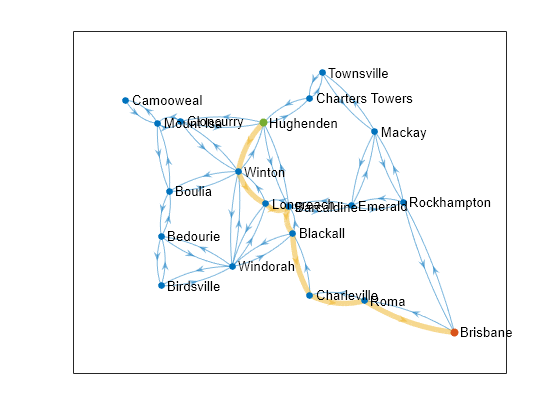plan
Description
Examples
Load the Queensland road network.
load("queenslandRoutes","places","routes")
Specify states, links, and weights for a navGraph object.
states = places.utm; % UTM coordinates of cities names = places.name; % Names of cities links = [routes.start routes.end]; % Adjacent cities weights = routes.time; % Travel time between adjacent cities
Create a navGraph object.
graphObj = navGraph(states,links,Weight=weights, ...
Name=names);Create a graph-based A* path planner.
planner = plannerAStar(graphObj);
Create a deep copy of the plannerAStar object.
planner2 = copy(planner)
planner2 =
plannerAStar with properties:
HeuristicCostFcn: @nav.algs.distanceManhattan
TieBreaker: 0
Graph: [1×1 navGraph]
Specify a heuristic function returns an estimated time to reach the goal.
planner.HeuristicCostFcn = @(state1,state2) ...
sum(abs(state1-state2),2)/100;Define the start and goal cities.
start = "Hughenden"; goal = "Brisbane";
Find the shortest path using the graph-based A* algorithm.
[pathOutput,solutionInfo] = plan(planner,start,goal);
Visualize the results.
h = show(graphObj); set(h,XData=graphObj.States.StateVector(:,1), ... YData=graphObj.States.StateVector(:,2)) pathStateIDs = solutionInfo.PathStateIDs; highlight(h,pathStateIDs,EdgeColor="#EDB120",LineWidth=4) highlight(h,pathStateIDs(1),NodeColor="#77AC30",MarkerSize=5) highlight(h,pathStateIDs(end),NodeColor="#D95319",MarkerSize=5)

Input Arguments
A* path planner, specified as a plannerAStar
object.
Start state of the path, specified as a positive integer, string scalar, character vector, or numeric vector.
Example: 1
Example: "Brisbane"
Example: [1095.91458671447 6947.04365801860]
Data Types: single | double | char | string
Goal state of the path, specified as a positive integer, string scalar, character vector, or numeric vector.
Example: 5
Example: "Hughenden"
Example: [208.622393818849 7691.91766093269]
Data Types: single | double | char | string
Output Arguments
Shortest path between states, returned as a numeric matrix.
Data Types: double
Solution information, returned as a structure. The fields of the structure are:
| Field | Description |
|---|---|
IsPathFound | Indicates whether a path has been found. Returns
|
PathStateIDs | List of IDs of the states along the path found by A*. By default, the IDs are the numeric indices of the states in the graph object. If you specify names for the states while constructing the graph object, this field contains the names instead. |
PathCost | Total cost of the path. If no path is found, then the cost is
|
ExploredStateIDs | List of IDs of the states explored by A* during the search. By default, the IDs are the numeric indices of the states in the graph object. If you specify names for the states while constructing the graph object, this field contains the names instead. |
NumExploredStates | Number of states explored during the search. Equal to the length of
the |
Data Types: struct
Extended Capabilities
C/C++ Code Generation
Generate C and C++ code using MATLAB® Coder™.
Version History
Introduced in R2023a
See Also
MATLAB Command
You clicked a link that corresponds to this MATLAB command:
Run the command by entering it in the MATLAB Command Window. Web browsers do not support MATLAB commands.
选择网站
选择网站以获取翻译的可用内容,以及查看当地活动和优惠。根据您的位置,我们建议您选择:。
您也可以从以下列表中选择网站:
如何获得最佳网站性能
选择中国网站(中文或英文)以获得最佳网站性能。其他 MathWorks 国家/地区网站并未针对您所在位置的访问进行优化。
美洲
- América Latina (Español)
- Canada (English)
- United States (English)
欧洲
- Belgium (English)
- Denmark (English)
- Deutschland (Deutsch)
- España (Español)
- Finland (English)
- France (Français)
- Ireland (English)
- Italia (Italiano)
- Luxembourg (English)
- Netherlands (English)
- Norway (English)
- Österreich (Deutsch)
- Portugal (English)
- Sweden (English)
- Switzerland
- United Kingdom (English)